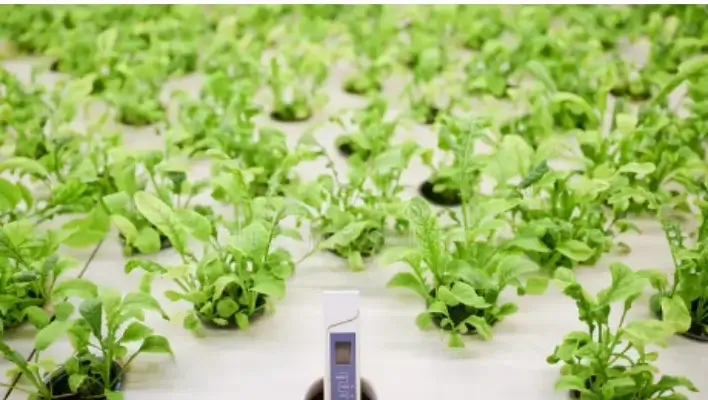Electrical Conductivity (EC) and pH play a vital role in growing vegetables in Hydroponic environment. Hydroponic is a technique of growing plants in a water environment. In this situation, the optimum nutrient absorption attracts much attention.
This article offers insights into EC and pH and their role in nutrient uptake. EC integrates with pH to optimize the uptake of nutrients in a hydroponic environment.
What is EC?
It quantifies how well a substance allows the flow of electric charge, typically in the form of electrons or ions. Conductivity is affected by various factors, including temperature, the presence of ions, etc.
What is EC in Hydroponics? | What is EC in Water?
In Hydroponics vegetables, water provides a sole medium for nutrient uptake. Besides, these nutrients are water soluble and exist as readily available ions for absorption. Therefore, delivering the right proportion of the required nutrients at the right time is important.
Additionally, EC can help you adjust your hydroponic vegetables’ specific nutrient requirements. Thus, you can manage conditions for your vegetable to thrive.
EC is a vital metric for measuring the concentration of dissolved salt ions in the nutrient solution. You can attach a concept of pH to EC to optimize the nutrient uptake. Thus, it serves as a two-pronged tool for managing your hydroponic system.
Table 1: Optimum pH and EC for Common Vegetables
| Plant Type | Optimum pH | Optimum EC Range (mS/cm) |
| Tomato | 5.5-6.5 | 2.0-2.5 |
| Lettuce | 5.5-6.0 | 1.2-1.8 |
| Peppers | 5.8-6.2 | 1.5-2.0 |
| Cucumbers | 5.5-6.0 | 1.6-2.0 |
Table 2: Optimum pH and EC for Common Indoor Plants
| Plant Type | Optimum pH | Optimum EC Range (mS/cm) |
| Basil | 5.5-6.5 | 1.5-2.0 |
| Mint | 6.0-7.0 | 1.0-1.5 |
| Spinach | 6.0-7.0 | 1.5-2.0 |
| Dwarf Marigold | 5.8-6.2 | 1.2-1.7 |
What is the best EC Reading for Hydroponics?
As the concentration of dissolved ions in water increases, its EC value will also be higher, and vice versa. Depending on the plant species, the optimum EC values typically range between 1.0 and 2.5 milliSiemens/centimeter (mS/cm) in a hydroponic environment.
We are concerned when the EC values are Low or High as they badly affect the growth of our plant. Low EC (<1.0 mS/cm) indicates dilution and insufficient concentration of nutrients in the water. This deficiency will lead to yellowing leaves and stunted growth.
While high EC (>2.5 mS/cm) indicates an excess of water nutrients, the obvious symptoms are stress, such as leaf burn and reduced flowering.

How to Measure EC in Hydroponics?
A Combo EC & pH meter is used to measure both EC and pH of water or nutrient solution. It is better to buy a meter with an LCD display for accurate observation. You can not only use it for hydroponics but also for aquaculture and aquaponics. You can shop it from the local market or online.
To use the meter, simply immerse the probe into the nutrient solution, ensuring it’s fully submerged. Wait for the readings to stabilize, typically within a few seconds, and then note the displayed EC value.
Remember to clean the probe thoroughly between measurements to maintain accuracy. With this straightforward method, growers can confidently monitor and adjust nutrient concentrations, ensuring optimal conditions for plant growth in hydroponic systems.
How to adjust ppm in Hydroponics?
Adjusting PPM (Parts Per Million) in hydroponics is like setting the right nutrition level for your plants. PPM measures how many nutrient particles are in your water. Think of it as the nutrient’s strength. If PPM is too high, plants might get overwhelmed, like eating too much junk food.
Too low, and they’re missing out, like skipping meals. For most hydroponic plants, aim for a PPM of 500-1000. To check PPM, use a TDS (Total Dissolved Solids) meter. It tells you how many particles are in the water, guiding you to add or reduce nutrients.
Adjusting PPM with TDS readings keeps your plants growing strong and healthy.
What is pH?
pH stands for Hydrogen Ion concentration in a solution. It is the concentration of Hydrogen Ions in solution and ranges from 0 to 14.
What Do the pH Values Indicate?
pH requirements vary from plant to plant. For example Lucky Bamboo need a pH value of 6.0-6.5You can use a pH meter or pH paper to measure the pH of your hydroponic solution.
The recommended pH range for the optimum uptake of nutrients is 5.5-6.5, though it can vary a bit from plant to plant. Lower pH values (<7) are towards the acid side, while high pH values (>7) are towards the alkaline side. We will also discuss the pH requirement for the individual plant.
What Causes pH to Drop in Hydroponics?
In hydroponics, when the pH level drops, it can cause many issues. This drop occurs because of various factors.
Firstly, the plants themselves can be the culprits. As they consume nutrients, they release acids into the water, which lowers the pH level, similar to adding a touch of sourness.
Another factor is the accumulation of salts and minerals over time. With continued feeding, these substances can build up, leading to a drop in pH.
Water quality also plays a significant role. If your water source is naturally acidic, it sets the stage for a lower pH level.
Lastly, microorganisms can break down organic matter, releasing acids into the hydroponic solution, further lowering the pH.
To maintain a stable pH, it’s essential to monitor it regularly and use pH adjusters when necessary, like adding seasoning to a meal. Remember, a balanced pH level ensures your plants stay healthy and happy in the world of hydroponics!
EC & pH for Hydroponics Go Together
EC value >2.5 mS/cm indicates a higher concentration of dissolved ions. Still, it does not clarify whether the ions from the acids or alkalis pH can help you resolve this issue. By knowing the pH and EC values, you can plan to optimize nutrient uptake of your hydroponic vegetables.
Managing EC & pH for Hydroponics
When the pH is 0-6, it is towards the acid side; its EC value will be higher (>2.5 mS/cm). Add one tablespoon of baking soda to three gallons if a solution is too acidic.
However, when the pH ranges from 8-14, it is towards the alkaline side. If a solution is too alkaline, add one tablespoon of white vinegar per four gallons of solution; its EC will be higher (2.5 mS/cm).
Indications of High EC, pH Values
High Electrical Conductivity (EC) and pH values in a hydroponic system can significantly impact the growth of vegetables, often leading to adverse effects. Here’s how:
Nutrient Imbalances
Elevated EC values indicate a high amount of soluble salts in the nutrient solution. This excess can result in nutrient imbalances, where certain essential elements become overly abundant, leading to toxicity. Vegetables may struggle to absorb water and essential nutrients, hindering their growth and overall health.
Reduced Water Uptake
High EC levels create an osmotic imbalance, making it challenging for plants to take up water effectively. This reduced water uptake can lead to dehydration, wilting, and overall plant water stress.
Proper hydration is crucial for nutrient transport and various physiological processes vital for growth.
Salt Accumulation
Excessive EC often results in the accumulation of salts in the growing medium or around the vegetable roots. This salt buildup can lead to salt toxicity, causing damage to root tissues and negatively impacting nutrient absorption. The accumulation of salts can further impede water uptake, exacerbating the stress on vegetables.
Leaf Burn
Elevated EC values contribute to the accumulation of salts on the surfaces of leaves and can cause leaf burn, manifested as browning or yellowing along the leaf margins. Leaf burn indicates that the plant struggles to manage the excess salts, leading to cellular damage and decreased photosynthetic efficiency.
Stunted Growth
The combined effects of nutrient imbalances, reduced water uptake, salt accumulation, and leaf burn often result in stunted vegetable growth. High EC values can hinder the development of roots, shoots, and overall biomass, leading to diminished yields and compromised vegetable vigor.
Altered Nutrient Uptake
Elevated pH values can also affect nutrient availability. When pH is too high, certain essential nutrients may become less soluble and less accessible and thus cause nutrient deficiencies. Even if the nutrients are present in the solution, leading to poor vegetable growth.
What Nutrient Deficiency Causes Yellow Leaves?
Yellow leaves in hydroponics often indicate nutrient deficiencies. Nitrogen, iron, and magnesium shortages can turn leaves yellow. Nitrogen supports leafy growth, iron maintains green color, and magnesium is essential for energy production.
Adjust your nutrient solution to ensure your plants get these vital nutrients for healthy, green leaves.
FAQs
In hydroponics, water pH plays a crucial role in plant growth. Research shows that when the pH level is too high or too low, nutrient absorption can drop by up to 50%, stunting plant growth.
For instance, if the pH is too high (alkaline), nutrients like iron become less available, leading to yellowing leaves.
On the other hand, if the pH is too low (acidic), essential nutrients like calcium can become overly abundant, leading to nutrient imbalances.
Maintaining the optimal pH level, typically around 5.5 to 6.5, maximizes nutrient uptake and ensures healthy, vigorous plant growth in hydroponics.
To raise pH in hydroponics and achieve the ideal range of 5.5 to 6.5, you can add a pH-up solution or use pH buffers like potassium carbonate. These products can help adjust the pH level effectively.
For example, adding 1 gram of potassium carbonate to 1 liter of water can increase the pH by about 0.2 units. It’s essential to monitor and make gradual adjustments to avoid drastic pH swings, ensuring your hydroponic plants thrive in the optimal pH range.
Conclusion
We need to understand that Electrical Conductivity and pH are closely related and are very important for the best growth of your hydroponic vegetables.
The values of EC generally vary from plant to plant, but general optimum values for the EC vary between 1.0 and 2.5 milliSiemens, while for the pH the range of values are 5.5-6.5.
These are the two important factors to consider in hydroponic growing. Moreover, also remember that EC and pH also go together as they are dependent on each other. The better management of EC and pH of your hydroponic system can give you a hydroponic crop of your choice.

